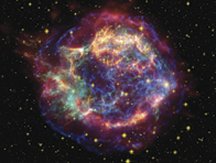As seen from Earth, a massive Milky Way star died in a supernova explosion some 325 years ago. But the dead star’s burned-out core isn’t fading away quietly. Astronomers have evidence that that the cinder recently underwent its own outburst.

In infrared portraits taken a year apart, NASA’s Spitzer Space Telescope examined Cassiopeia A, the youngest known supernova remnant in the galaxy. The remnant consists of an outer, shimmering shell of material expelled by the supernova explosion and a dense, collapsed core known as a neutron star.
The pictures show clumps and filaments of dust set aglow by radiation from Cassiopeia A. After analyzing how the dust features moved over a year’s time, George H. Rieke of the University of Arizona in Tucson and his colleagues realized that some clumps and filaments were in the wrong place to have been energized by radiation from the original supernova explosion. Radiation must have come from a much more recent upheaval within Cassiopeia A’s neutron star.
The dust’s glow represents the infrared echo of a recent outburst, says Rieke. His team estimates that the outburst occurred in 1953 and probably resulted from a rupture of the neutron star’s surface.
When the researchers calculated the direction of the outburst, they realized that it wouldn’t have been visible from Earth. Rieke and his colleagues, including Oliver Krause of the University of Arizona, report their findings in the June 10 Science.







